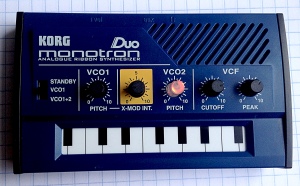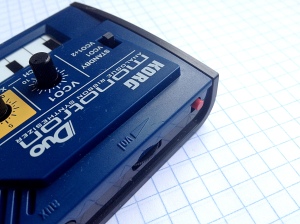I’m a softsynth guy for the most part. Why bother with heavy and space-consuming hardware when it can all live in your computer, right? But recently I’ve been craving something to fiddle with, something with dedicated controllers that I did not have to painstakingly assign or configure. And, oh yeah, something on the cheap.
The Monotron Duo is the second in Korg’s series of Monotrons (the first was the plain old monotron, the third is the Monotron Delay). The design and layout is a very simple but powerful monophonic subtractive synth with two oscillators, a low pass filter, an X-Mod knob for cross modulation between the two oscillators, and a ribbon controller.
The Oscillators
You can get a lot out of these little guys. Activate just one oscillator (VCO1 mode) with no cross modulation and you’ll get a very plain, biting, clipped saw/square. Add a little of the x mod the silent second oscillator will modulate the frequency of the first, giving you a mild detune at low intensity, and all sorts of craziness at high intensity. Activate VCO2 mode to get the second oscillator going. Your tonal center will be unrecognizable in no time. Hot tip: activate both oscillators in VCO2 mode, put them in unison or in octaves, turn the x mod up to 3 or 4 and you’ve got yourself a nice fat lead (that sounds like a lot more than just two voices).
There’s just a touch of leakage between the oscillators. Manipulating VCO2 when only VCO1 is activated (and cross modulation is set to zero) does produce a tiny amount of modulation. Also, if the cutoff is set low enough, you can hear a click on any note release.
The Ribbon Controller
You’ve got just over an octave in 4 different modes. Each press of the little red button will change the ribbon controller to the next mode, the order being continuous – chromatic – major – minor. Continuous sets the ‘keyboard’ to be truly continuous with no discernible pitch between one place on the keyboard and another, which is very useful for big slides and noise/effect creation. Chromatic mode will give you every note you see on the keyboard, which, for me, was a pretty clumsy endeavor. I found it was pretty difficult to really aim your finger in the right place with so many discrete notes packed into a 2+ inch space. Major and Minor mode set the keyboard to those respective scales. All you’ve got to do is drag your finger around and you’ve got a melody. With the non-harmonic notes out of the way, I found I could consistently play the notes I was aiming for. Use the VCO1 pitch knob to set C to the key of your tune (or another note, if you want to get modal) and go nuts.
Output
The little speaker is okay, I guess, but you’ll need to use the headphone jack to really hear the depth of this synth. On the downside, there is a faint stream of white noise audible at all times. You’ll either want to gate, remove, or find a way to make use of this noise. This device will not give you pristine output, even from the headphone jack.
Verdict
I’ve had an absolute blast with this thing, and have used it in recordings already. While this is, most definitely not a pristine engineered piece of equipment, it’s drawbacks if your goal is a little dirt and chaos. The thing to remember is that this is more of a deliberately messy noisemaker and less of a dedicated synth (at $50, what can you really expect).

